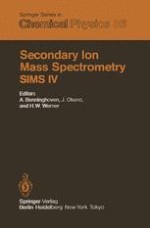1984 | OriginalPaper | Buchkapitel
A Comparison of Camera-Based and Quantized Detectors for Image Processing on an Ion Microscope
verfasst von : R. W. Odom, D. H. Wayne, C. A. Evans Jr.
Erschienen in: Secondary Ion Mass Spectrometry SIMS IV
Verlag: Springer Berlin Heidelberg
Enthalten in: Professional Book Archive
Aktivieren Sie unsere intelligente Suche, um passende Fachinhalte oder Patente zu finden.
Wählen Sie Textabschnitte aus um mit Künstlicher Intelligenz passenden Patente zu finden. powered by
Markieren Sie Textabschnitte, um KI-gestützt weitere passende Inhalte zu finden. powered by
Secondary ion mass spectrometry (SIMS)/ion microanalysis of materials surfaces is capable of detecting all the elements in the periodic table and provides the highest elemental detection sensitivity of all existing microanalytical techniques[l]. SIMS/ion microanalysis performed on the CAMECA IMS-3f Ion Microanalyser not only provides these elemental detection capabilities but also produces mass-selected ion images of the secondary ions formed during the sputtering process. These secondary ion images are produced by combining specialized secondary ion extraction and focusing ion optics with a stigmatic focusing mass spectrometer. The ion images are observed by converting the ion intensity into visible light through the use of a microchannel plate (MCP)/fluorescent screen image intensifier. Although the ion optics of the CAMECA IMS-3f are capable of resolving the lateral distribution of secondary ion emission down to a lateral resolution of ~0.3μm, the ion images produced on the standard imaging detector contain only a qualitative measure of the secondary ion signal intensity. The incorporation of a quantitative image detector (i.e. a detector which quantitates the ion intensity in the image) would provide a means of extending the microanalysis capabilities of the IMS-3f into areas such as three-dimensional depth profiling, multi-area, multi-element analysis and quantitative and lateral distribution analysis.
